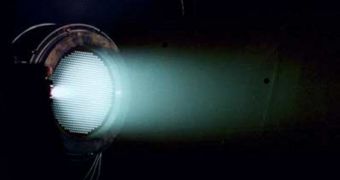The Hayabusa space mission, which literally translates into peregrine falcon, is a flight of the Japanese space agency (JAXA), which aimed at landing and retrieving soil samples from the near-Earth asteroid (NEO) 25143 Itokawa. The goal of the mission was to study the potentially dangerous object thoroughly, and then land on it and retrieve samples. Hayabusa failed to do so in 2005, but its sample chambers were sealed nonetheless, as hopes were high that dust swirled inside them. Now on its way home, the probe is again stricken by bad luck, with one of its ion thrusters failing, Space reports.
Mission controllers at JAXA have announced that another of its ion motors failed last week, leaving the spacecraft to navigate the harsh cosmic environment only with a single, already-damaged engine. The space probe had no less than four experimental microwave discharge ion engines, which relied on xenon gas for their operation. The gas was consumed, and the resulting ionized propellant was then discharged at high speeds to generate thrust. But two of the motors had already failed before the last glitch, last Wednesday.
The anomaly that claimed the life of thruster D is of the same kind that claimed that of another of its motors, back in 2007. A voltage spike in a neutralization vessel is believed to have been the main culprit in both instances. The only working device on Hayabusa remains Thruster C, which had already been shut down by engineers, due to fear that it could also succumb to voltage spikes. But mission planners are now reviewing its diagnostics, in an attempt to determine whether or not the instrument can support long-duration firings of the type that is required to bring the probe back to Earth.
In November 2005, Hayabusa became the first spacecraft ever to take off from an asteroid, after it landed on 25143 Itokawa unintentionally. It spent some 30 minutes on its surface, breaking new records for space exploration. During its studies of the space rocks, it collected more than 1,600 pictures of the structure and also about 120,000 pieces of near-infrared spectral data. A further 15,000 X-ray spectrometer data points were also collected, JAXA reports.

 14 DAY TRIAL //
14 DAY TRIAL //